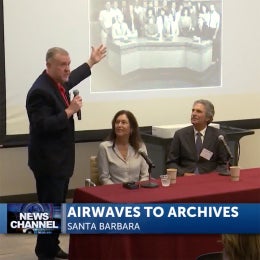
UC Santa Barbara Library is celebrating the preservation and digitization of the KEYT Television Archive, a collection documenting more than 60 years of Santa Barbara history and community journalism.
Donated to the Library in 2016, the archive includes over 2,700 videotapes and millions of feet of 16mm film, capturing daily newscasts, special programs, sports, and major local events. Approximately 20 percent of the videotape collection has been digitized to date, with most daily news already accessible through the Library’s streaming platform.
"In my experience as an archivist, working with TV archives is pretty rare," said Laura Treat Liebhaber, the Library’s Curator of Film & Television and Santa Barbara Local History Collections, who curates the KEYT collection. "Events come to life in a way they just simply can’t in a photo or document." She emphasized the urgency of preservation: "Across the nation, 80 percent of local television recorded before 1995 is lost, and what’s left could be gone by 2040 without an effort to preserve it."
"This archive is a unique treasure that pushes back on the idea that recency should be our most important value," said local journalist Jerry Roberts. "A remarkable history of decades of one of California’s most consequential regions, the KEYT collection shows that our shared memory did not begin with the internet. Protecting and digitizing this material is an act of civic responsibility by the UCSB Library that ensures future generations can see how we got here, and how it happened in the day-to-day real lives of real people."
In October 2025, the Library hosted "From Airwaves to Archives," an event celebrating the preservation and digitization of the collection. The featured a panel discussion with veteran KEYT journalists Tracy Lehr, John Palminteri, and Paul Vercammen, moderated by KEYT General Manager Jim Lemon. The event also recognized the vital role of archivists, videographers – including longtime KEYT videographer Herb Tuyay – and UCSB Library staff in making these materials accessible.
While the videotape collection is processed and housed in climate-controlled storage, millions of feet of 16mm film remain to be preserved and digitized. Once completed, the collection will support teaching, research, and community engagement, with potential uses in course instruction, documentary projects, and local media programming.
UCSB Library continues its efforts to expand access to this rich historical resource, ensuring that Santa Barbara’s broadcast history becomes available for scholars, students, and the public.


